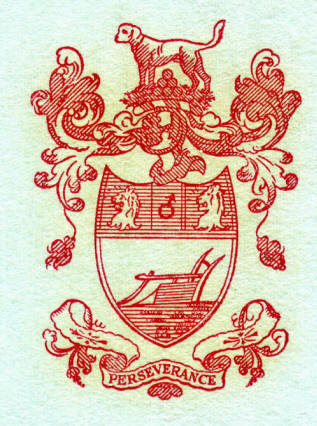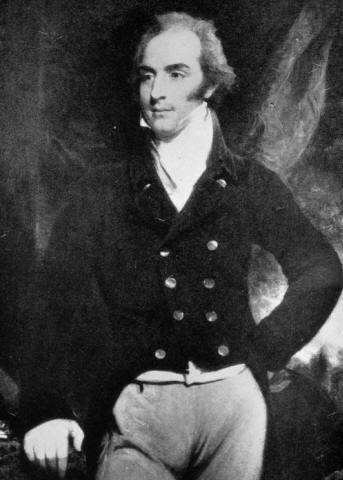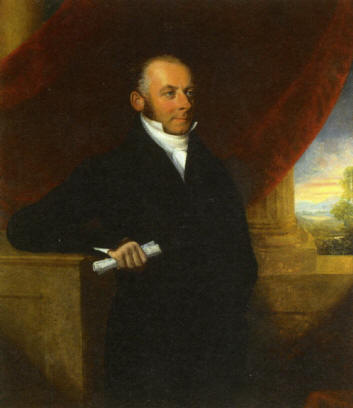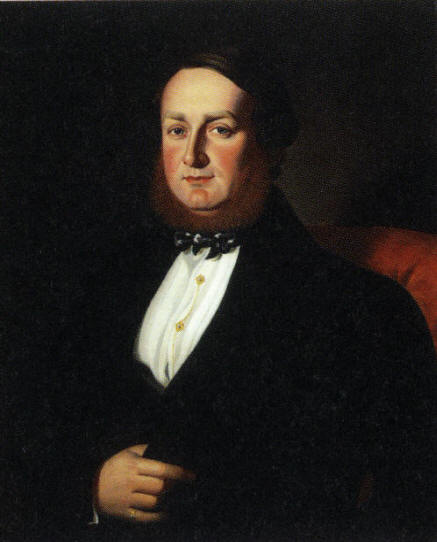|






| |
|
The Crawshays of
Cyfarthfa |
| |
| The Crawshay Family Coat of Arms. |
|
 |
| |
|
Richard Crawshay c. 1800
Painting by
Richard Wilson |
|
 |
| |
RICHARD
CRAWSHAY
Contrary to popular belief this
family did not set up the Cyfarthfa Ironworks although they
eventually managed to obtain sole ownership. The
first Crawshay to travel to Merthyr Tydfil was Richard
Crawshay
(1739 - 1810),
the son of a
Yorkshire yeoman
born
at Normanton,
near Leeds. He
quarrelled with his father and at only 16 years of age travelled
to London
without money. He sold his pony for £15, and took employment in
an iron-warehouse selling flat-irons.
After marrying the owner’s daughter he became sole proprietor
and wealthy. Hearing of the iron-works in
South Wales
offering scope for investment, he came to
Merthyr,
took over
Homfray
's lease at
Cyfarthfa for boring cannon,
and after the death in 1786 of Anthony Bacon he secured the
lease of the Cyfarthfa
works during the minority of
Bacon’s
eldest son. Through cunning business methods he bought this
young man’s share and became sole proprietor in 1794. He adopted
Cort
's methods of puddling (known
later as the Welsh Method), established rolling mills,
built new furnaces and forges. Richard also
became one of the chief promoters of the
Glamorgan Canal
which was opened from Merthyr
to Cardiff
in 1794. He took full advantage of the boom in the iron trade
and of the need for cannon caused by the
Napoleonic wars.
A contemporary described him as a large red faced man with a
pock marked face and a loud voice. Richard’s proudest moment was
in 1801 when he welcomed Lord Nelson and Lady Hamilton to his
ironworks. At first he did not put any faith in steam power and
the new experiments of Richard Trevithick and he placed a bet
against the historic journey made by Trevithick in 1804 when he
made a journey from Penydarren to Abercynon. He assisted by his
two young nephews,
Joseph
and
Crawshay
Bailey
and Benjamin Hall (the man who Big Ben is supposed to be named
after) also had shares in Cyfarthfa.
It has been said that in 1810 Richard
Crawshay was amongst the 50 richest men in Britain.
|
|
|
| |
|
 |
|
|
| |
| |
WILLIAM
CRAWSHAY
I (1764 - 1834),
Richard
's only son, did not take a great deal of
interest in the manufacture of iron but
took charge of the selling agency
at the George Yard
, Upper Thames Street
, London,
leaving his son,
William
Crawshay
II to manage the works at
Cyfarthfa
and Hirwaun
. It is said that he was ‘the most statesmanlike of the
Crawshay Iron
Kings,’ and guided the huge
enterprise in all its aspects with a steady hand maintaining its
production and commercial success. He bought both
Benjamin
Hall
's and
Joseph
Bailey
's shares and became the sole proprietor.
William was successful and the probate of his will was granted
at £700,000. He left three sons and two daughters and his
elegant portrait is in Cyfarthfa Castle.
|
|
|
| |
| William Crawshay II c. 1830 |
|
 |
| |
| |
WILLIAM
CRAWSHAY
II (1788 – 1867) was the
day to day manager
of the Cyfarthfa
and Hirwaun
works, and bought other iron-works at
Treforest and in the
Forest of Dean.
It is he who is generally called the ‘Iron
King’ and who built
Cyfarthfa castle
and the Caversham Park mansion.
His father thought that spending £25,000 on Cyfarthfa Castle was
a needless extravagance. During his period the works grew
immensely, and enormous quantities of iron were manufactured and
great quantities of coal raised to feed the furnaces. His
attitude during the celebrated riots at
Merthyr
tended to exasperate and defy the men. His account in the
Observer newspaper lack all sympathy for those involved. He left
Treforest iron-works
to his son Francis,
the Forest of Dean
to Henry
and the Cyfarthfa
works to his youngest son,
Robert
Thompson
Crawshay
Besides these important works, he also held
many shares in the Taff Vale Railway.
|
|
|
| |
| Robert Thompson Crawshay |
|
 |
| |
| |
ROBERT
THOMPSON CRAWSHAY
(1817 - 1879) was born at
Cyfarthfa. He was
the youngest son of William II and his mother belonged to the
Thompson family of ironmasters from Cumbria. During his father’s
lifetime Robert was given Cyfarthfa
works and its castle to manage. His ‘reign’ started
optimistically as he and his wife,
Rose Mary
Crawshay,
helped in the provision of local
schools and libraries for the
workforce and in providing books to read. He had an interest in
music and began the Cyfarthfa band but, after becoming deaf, he
took up photography. The two disasters in the Cyfarthfa owned
Gethin pits earned him a lot of criticism in the 1860s. He was
buried at Vaynor
parish churchyard under a heavy stone
slab engraved with the words ‘God Forgive Me’. This has
been interpreted as meaning that he was sorry for closing the
Cyfarthfa works in 1874. By refusing to speak to the Unions he
had made over a thousand workers destitute. On the other hand a
finger has been pointed at the strange way he behaved towards
his own family; especially his relationship with the daughter
who helped with his photography but was disinherited when she
married. It is clear that he became a
tyrant after a stroke in the 1860s which caused him gradually to
become crippled and deaf with deteriorating sight. His sons
carried on the business under the name of
Messrs. Crawshay Bros.
until they sold to Messrs. Guest,
Keen, and Nettlefolds in 1902.
|
|
|
| |
| Francis Crawshay c. 1845 |
|
 |
| |
| |
|
Francis
Crawshay's racing schooner 'Mamgu' under construction at Shon Harri
Bach's Boatbuilders yard, Wotton, Isle of Wight.
(Photograph
courtesy of Cyfarthfa Castle Museum and Art Gallery) |
|
 |
| |
| |
| |
| |
| |
|
|
|
|

To the Page Index |

To Cyfarthfa
Page |

To the Map |
|
|
|
|
 |
| |
|






